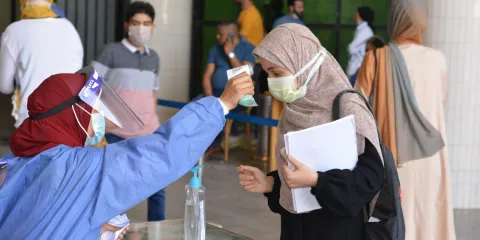Virtual dialogue on responses to NCDs in the Eastern Mediterranean region

Next week, we will be hosting the last of our regional multistakeholder dialogues ‘Inspiring Change, Putting People First: Shaping Responsive Health Systems for people living with NCDs in the COVID-19 era’. On this occassion, we will be focusing the discussion on NCD responses in the Eastern Mediterranean Region. This virtual dialogue is open to all!
Delivering people-centred healthcare is widely recognised as a core aim of health systems around the world. Given the impact of COVID-19, there is growing recognition that prevention and health delivery models need to be driven by the needs of affected populations and acknowledge the value of lived experiences. This event will take stock of the current status of progress on noncommunicable diseases (NCDs) and Universal Health Coverage (UHC) in the Eastern Mediterranean region and region-specific gaps, opportunities, and good practice to accelerate efforts on NCDs. Discussions made on the day will also feed into a broad consultative process that will contribute towards a Global Charter on Meaningful Involvement of People Living with NCDs.
The Eastern Mediterranean joint regional dialogue, held with the support of Novo Nordisk is the last in a series of dialogues that have taken place in all World Health Organization (WHO) regions.
This event will be simultaneously translated from English to Arabic.
Tuesday 22 June 2021 | 3:00 p.m. – 5:00 p.m. CEST. Register here!
Speakers include:
- Dr Zied Mhirsi, Director at Global Health Strategies; Co-founder of the Tunisian Center for Public Health (Moderator)
- Dr Maha El Rabbat, Professor of Public Health; Cairo University - Special Envoy of WHO Director - General on COVID-19, Egypt
- Mr Omar Abu Reesh, Person with Lived Experience, Jordan
- Dr Asmus Hammerich, Director, Noncommunicable Diseases and Mental Health, WHO EMRO
- Dr Ibtihal Fadhil, Founder and Chairperson, Eastern Mediterranean NCD Alliance
- Dr Claudia Truppa, Health Coordinator, International Committee of the Red Cross, Lebanon
- Mr Khurram Hashmi, Technical Advisor, The Union, Pakistan
- Mr Mohamed Shankhair, Person with lived experience, Amman, Jordan
- Ms Soraya Ramoul, Senior Director, Global Access to Care, Novo Nordisk
- Mr Bryson Childress, Director, Global Programs at American College of Cardiology
- Pr Mohamed Sobhy, President of Cardiovascular Research, Education, Prevention Foundation (CVREP)
In addition, NCD Alliance is co-hosting a series of Our Views, Our Voices regional meetings. These civil society only meetings are focused on building a shared understanding of meaningful involvement of people living with NCDs. NCDA members are invited to nominate up to 4 representatives, including people living with NCDs, here. This meeting will take place on Wednesday 23 June 2021 and is co-hosted by the Eastern Mediterranean NCD Alliance.